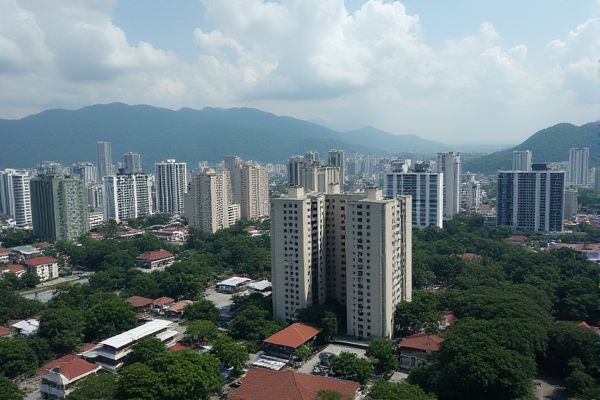
Transportation and commuting in Indonesia: Extensive public transportation network available. Online ride-hailing apps widely used. Traffic congestion in major cities. Affordable motorcycle taxis (ojeks). Railway services connecting key regions. Frequent intercity bus services available. Domestic flights for island hopping. Public transport often crowded. Comprehensive road network improvements ongoing. Cyclists face challenging urban conditions.
Extensive public transportation network available.
Jakarta boasts an extensive public transportation network, including the TransJakarta bus rapid transit system, Jakarta LRT, Jakarta MRT, KRL Commuterline, Jabodebek LRT, and the Soekarno-Hatta Airport Rail Link. This network also integrates various bus services, such as Kopaja, MetroMini, and Mayasari Bakti, with a significant expansion in routes and buses over the past decade. The goal is to cover 95% of the city's area by public transport services, enhancing connectivity and accessibility for residents and visitors. For more comprehensive information, you can visit the detailed overview of Transport In Jakarta, which delves into the intricacies and developments of this robust transportation system.
Online ride-hailing apps widely used.
In Indonesia, the most widely used online ride-hailing apps include Gojek, Grab, Maxim, inDrive, and BlueBird Taxi. These apps offer a range of services such as taxi rides, motorbike rides, food delivery, and digital payments. Gojek and Grab are the dominant players in the market, known for their reliability, user-friendly interfaces, and comprehensive service offerings.
Traffic congestion in major cities.
Indonesia's major cities, including Jakarta, Bandung, Semarang, Surabaya, and Yogyakarta, are experiencing chronic traffic congestion due to a significant increase in vehicle numbers. With around 125 million vehicles on the roads, there has been a 300% increase in traffic since 2004. A high proportion of these vehicles are powered two-wheelers, contributing significantly to the congestion challenges. For more information, you can visit the World Highways website, which provides further insights and developments regarding the infrastructure and traffic management issues in these regions.
Affordable motorcycle taxis (ojeks).
In Indonesia, affordable motorcycle taxis known as "Ojeks" are a common and fast form of transportation, particularly in urban areas like Jakarta, Surabaya, and Medan. Ojeks are often the fastest way to navigate through traffic congestion, with fares ranging from 5,000 to 10,000 rupiah (about US$0.50 to US$1.00) for short trips. They are frequently used due to their low cost and efficiency. For more detailed information on this mode of transportation, you can visit their entry on Motorcycle Taxi.
Railway services connecting key regions.
Indonesia's railway services are primarily concentrated on Java, with extensive networks connecting major cities like Jakarta and Surabaya. The country also has separate railway systems in Sumatra, Kalimantan, and Sulawesi, with ongoing projects to expand and connect these networks. A noteworthy development is the recently launched high-speed rail line between Jakarta and Bandung, which significantly reduces travel time.
Frequent intercity bus services available.
Frequent intercity bus services in Indonesia connect major cities across the country, including routes like Jakarta to Surabaya, Bali to Yogyakarta, and Jakarta to Malang. These routes feature various bus operators that prioritize comfort, safety, and reliability for travelers. Notably, [Bus Online Ticket](https://www.busonlineticket.com/id-en/bus-tickets) offers convenient booking options, including sleeper buses for long-distance journeys, ensuring a smooth and pleasant travel experience.
Domestic flights for island hopping.
Domestic flights in Indonesia are a crucial mode of transportation for island hopping, with low-cost carriers like Citilink, Lion Air, and Sriwijaya Air offering affordable options, while Garuda Indonesia provides more reliable and punctual services. These flights connect major cities and remote islands, significantly reducing travel time compared to other modes of transport. To learn more about this essential aspect of Indonesian travel, visit the article on Lonely Planet, which provides insightful information about navigating this beautiful archipelago.
Public transport often crowded.
Public transportation in Jakarta often struggles with overcrowding, a situation exacerbated by the COVID-19 pandemic as people seek to avoid crowded conditions, thus underscoring the urgent need for improvements in the city's transit services. Enhancements such as reduced waiting times, improved ease of access, and closer proximity of bus stops and stations are essential. Despite substantial efforts to expand public transportation, including the introduction of the TransJakarta Bus Rapid Transit System, the reliance on public transport remains low. Only about 27% of commuters utilize public transportation, leaving the majority dependent on motorcycles and private cars, which significantly contribute to traffic congestion. For more detailed information on the initiatives underway, you can visit the Transport in Jakarta page.
Comprehensive road network improvements ongoing.
Indonesia is undertaking several comprehensive road network improvement projects to enhance the strategic national road network, reduce transport costs, and improve road management mechanisms across various provinces. This includes notable initiatives such as the Regional Roads Development Project (RRDP), Eastern Indonesia National Road Improvement Project (EINRIP), and Western Indonesia Road Improvement Project (WINRIP). These ambitious projects involve road widening, new road construction, and bridge improvements, all focused on spurring economic growth and ensuring efficient road asset management across the country.
Cyclists face challenging urban conditions.
Cyclists in Jakarta face significant challenges, including unsafe roads, aggressive drivers, high vehicle speeds, and the lack of protected cycle lanes, which are crucial for their safety and comfort. Despite increasing cycling popularity, issues such as unmaintained roads and the replacement of protective barriers with less effective measures like road spikes continue to pose risks to cyclists. For more information on how bicycles could be the future mode for traffic-choked Jakarta, visit the ITDP website.
